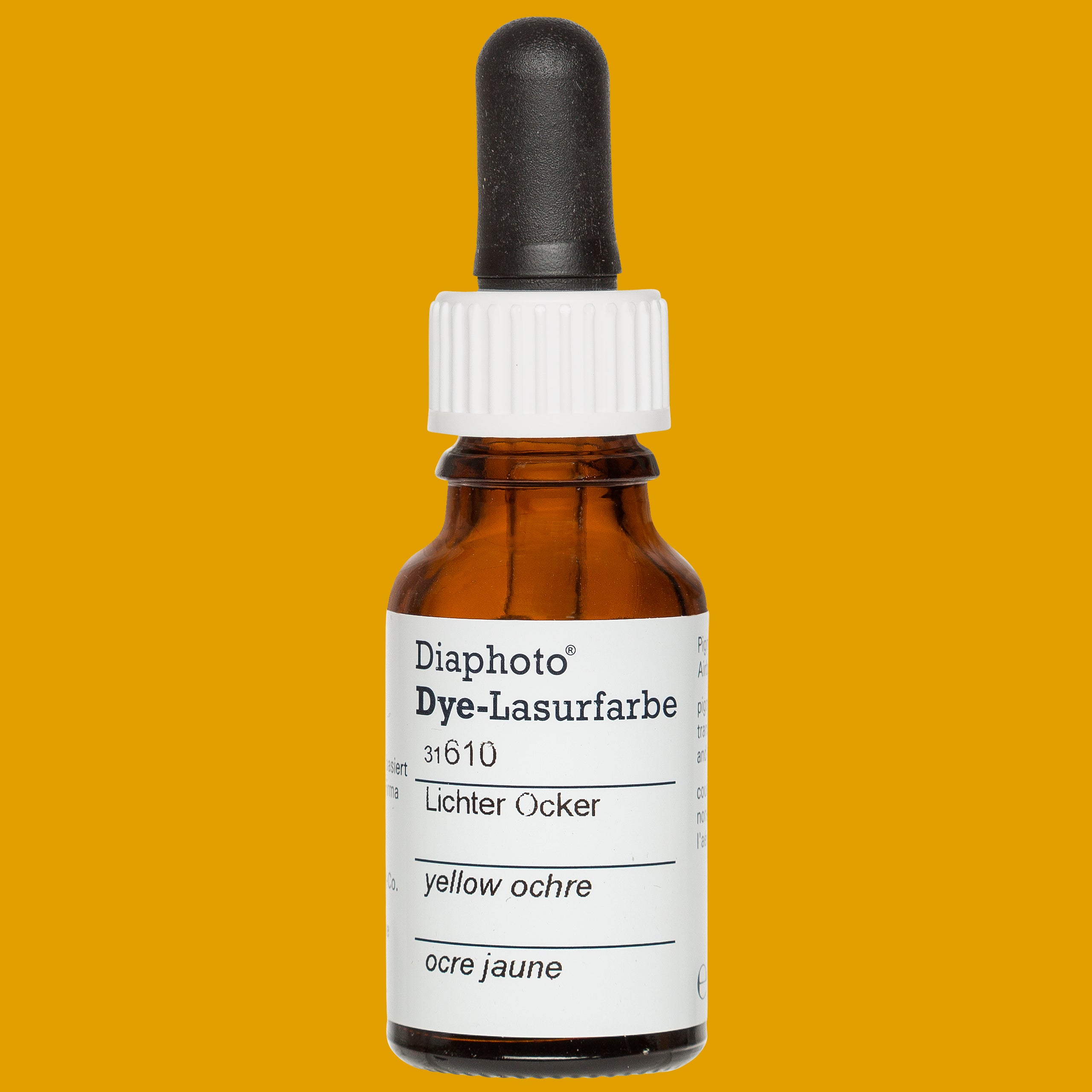



























Rohrer & Klingner DIAPHOTO glaze paint
Tax included. Shipping calculated at checkout
Delivery time within Germany: 1 - 3 working days
Egg white glaze paint for retouching and coloring silver gelatin color and black and white photos and also for repairing cyanotypes or other fine prints.
- suitable for PE and baryta papers, as well as fine printing papers
- 12ml in a glass bottle
- with pipette
(The actual color may vary slightly from the color shown here depending on your monitor display.)
Notes on image retouching
Using the egg white glaze colors, annoying white dots, dust or small errors in the negative can be repaired.
In our experience, a good starting value is 1 drop of jet black + 5 drops of distilled water.
If the paint is too wet, it will leave more visible retouching marks, especially if you look at the picture at a slight angle against the light. Dab off any excess paint on a test sheet of photo paper until the brush is almost dry.
If you need the darkest possible shade, it is better to layer a lighter (drier) shade several times until the desired color depth is achieved, rather than working directly with very dark and runny paint.
You should imagine that you are using the fine tip of the brush to transport the color to the white point in the picture. That's why you should not paint, but dab!
To retouch small dust spots or lint, we recommend using a brush that is as fine as possible, such as our Da Vinci Restauro 3/0.
In general, practice makes perfect. Analogue image retouching requires a steady hand, some practice and, above all, a lot of patience.
Notes on coloring
Here, too, a ceramic palette is very helpful for mixing the right color beforehand or diluting the paint with distilled water. The colors are very concentrated and it is recommended that they be heavily diluted with water.
To achieve denser, darker shades, the paint must be applied several times in a glaze similar to watercolor painting. It is also important that the surface is as free of grease as possible so that the paint can be properly absorbed into the emulsion, so avoid grease stains from fingerprints at all costs.
Papers with a matte surface are generally easier to color than glossy paper.
You will find all the colors that are still available here, and further variations can be created by mixing the colors.
For coloring, we recommend a slightly thicker brush, such as our Davinci Restauro 0.2 or 4.
information on product safety
Manufacturer:
ROHRER & KLINGNER KG
Meininger Straße 1-3
D-98544 Zella-Mehlis
info@rohrer-klingner.de
Choose options




























Tax included. Shipping calculated at checkout
Egg white glaze paint for retouching and coloring silver gelatin color and black and white photos and also for repairing cyanotypes or other fine prints.
- suitable for PE and baryta papers, as well as fine printing papers
- 12ml in a glass bottle
- with pipette
(The actual color may vary slightly from the color shown here depending on your monitor display.)
Notes on image retouching
Using the egg white glaze colors, annoying white dots, dust or small errors in the negative can be repaired.
In our experience, a good starting value is 1 drop of jet black + 5 drops of distilled water.
If the paint is too wet, it will leave more visible retouching marks, especially if you look at the picture at a slight angle against the light. Dab off any excess paint on a test sheet of photo paper until the brush is almost dry.
If you need the darkest possible shade, it is better to layer a lighter (drier) shade several times until the desired color depth is achieved, rather than working directly with very dark and runny paint.
You should imagine that you are using the fine tip of the brush to transport the color to the white point in the picture. That's why you should not paint, but dab!
To retouch small dust spots or lint, we recommend using a brush that is as fine as possible, such as our Da Vinci Restauro 3/0.
In general, practice makes perfect. Analogue image retouching requires a steady hand, some practice and, above all, a lot of patience.
Notes on coloring
Here, too, a ceramic palette is very helpful for mixing the right color beforehand or diluting the paint with distilled water. The colors are very concentrated and it is recommended that they be heavily diluted with water.
To achieve denser, darker shades, the paint must be applied several times in a glaze similar to watercolor painting. It is also important that the surface is as free of grease as possible so that the paint can be properly absorbed into the emulsion, so avoid grease stains from fingerprints at all costs.
Papers with a matte surface are generally easier to color than glossy paper.
You will find all the colors that are still available here, and further variations can be created by mixing the colors.
For coloring, we recommend a slightly thicker brush, such as our Davinci Restauro 0.2 or 4.
information on product safety
Manufacturer:
ROHRER & KLINGNER KG
Meininger Straße 1-3
D-98544 Zella-Mehlis
info@rohrer-klingner.de
If you have any questions or concerns, please do not hesitate to contact us.
Best shipping
We ship your goods as quickly and safely as possible.
We process your payment information and other data securely.
